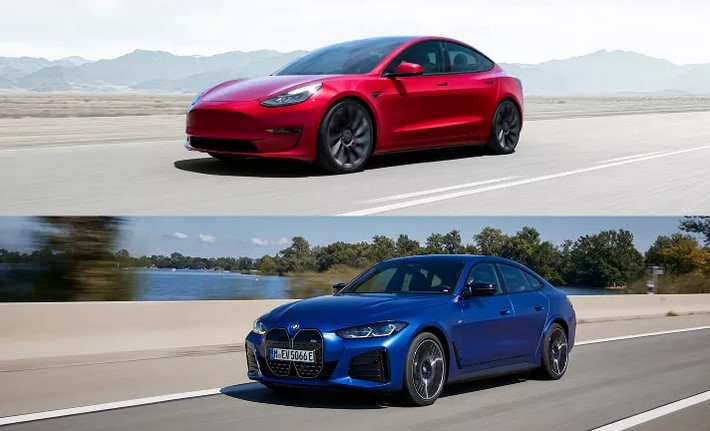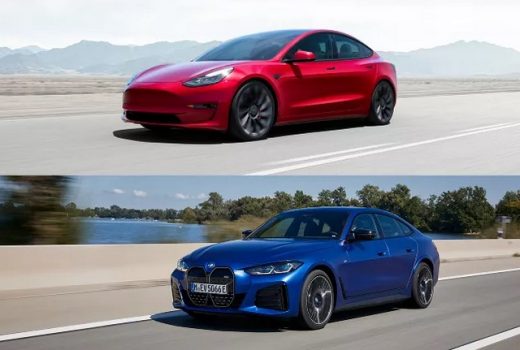i4 vs Model 3: Comparing Electric Vehicles for the Future

Source : https://cdn-fastly.autoguide.com
In recent years, the electric vehicle (EV) market has seen significant growth, with manufacturers racing to develop cars that combine performance, sustainability, and cutting-edge technology. Among the most notable contenders in the market are the BMW i4 and the Tesla Model 3, two electric sedans that are shaping the future of driving. Both cars offer distinct advantages, from impressive performance to sleek designs, but they differ in several key areas, including driving dynamics, technology, and overall value. In this article, we will take a closer look at the i4 vs Model 3 comparison, exploring their similarities and differences to help you determine which is the better fit for your electric driving needs.
1. Performance and Driving Experience
When it comes to electric vehicles, performance is one of the most important factors for many consumers. The BMW i4 and Tesla Model 3 both offer excellent driving experiences, but their performance characteristics are influenced by different engineering philosophies.
1.1 BMW i4 Performance
The BMW i4 is part of BMW’s push into the electric vehicle market, and as expected, it maintains the brand’s reputation for a refined and sporty driving experience. The i4 is available in two versions: the i4 eDrive40 and the high-performance i4 M50. The eDrive40 features a single motor producing 335 horsepower, while the i4 M50 offers an impressive 536 horsepower from dual electric motors, allowing it to accelerate from 0 to 60 mph in just 3.7 seconds.
BMW emphasizes driving dynamics, with the i4’s balanced handling, smooth ride, and precise steering. The vehicle’s low center of gravity, owing to the placement of the battery pack, contributes to an agile driving experience, particularly in the sportier M50 model. The i4 also boasts a range of up to 301 miles, which is competitive in the EV market and suitable for most daily driving needs.
1.2 Tesla Model 3 Performance
The Tesla Model 3, widely regarded as one of the best-selling electric vehicles in the world, offers a range of performance options, from the standard Model 3 to the high-performance Model 3 Performance. The Model 3 Standard Range Plus features a single motor and produces 283 horsepower, while the Model 3 Performance, equipped with dual motors, delivers a blistering 450 horsepower and can accelerate from 0 to 60 mph in just 3.1 seconds.
Tesla is known for its exceptional straight-line speed and dynamic performance, and the Model 3 is no exception. It features instant torque delivery, making it incredibly responsive and fun to drive. The Model 3’s steering is light and precise, but its handling tends to lean toward comfort over sportiness compared to the i4. The Model 3 offers a range of up to 358 miles, depending on the variant, making it one of the top contenders in terms of long-range EV driving.
2. Technology and Infotainment
Technology is another area where the i4 vs Model 3 comparison becomes especially relevant. Both BMW and Tesla have invested heavily in the latest innovations to ensure that their vehicles are not only efficient but also packed with advanced features that make the driving experience more enjoyable and connected.
2.1 BMW i4 Technology
The BMW i4 comes with the brand’s iDrive 8 system, which includes a large curved display consisting of a 12.3-inch digital gauge cluster and a 14.9-inch infotainment touchscreen. The system is intuitive and highly responsive, featuring both touch controls and a rotary dial for easier use while driving. The i4 offers a suite of advanced driver assistance features, including adaptive cruise control, lane-keeping assist, parking sensors, and more.
BMW also offers over-the-air updates, ensuring that the i4 can receive software improvements and new features long after purchase. The i4’s interior is luxurious, with high-quality materials and attention to detail that enhances its premium feel. Additionally, the i4 is available with an array of comfort and convenience options, such as heated seats, a panoramic sunroof, and ambient lighting.
2.2 Tesla Model 3 Technology
Tesla is synonymous with cutting-edge technology, and the Model 3 is no exception. The centerpiece of the Model 3’s interior is a massive 15-inch touchscreen that controls nearly every aspect of the vehicle. This minimalist approach to the dashboard layout may take some getting used to for new drivers, but it offers a clean and modern look. The system integrates navigation, media, climate control, and even vehicle settings, offering a seamless user experience.
Tesla’s Autopilot and Full Self-Driving packages are among the most talked-about technological features in the automotive world. While Autopilot provides semi-autonomous driving features, such as adaptive cruise control, lane centering, and automatic lane changes, Full Self-Driving takes this a step further, offering automated parking, Navigate on Autopilot, and the ability to recognize stop signs and traffic lights. Though these systems are not fully autonomous, Tesla is continuously improving them through over-the-air updates, keeping the Model 3 on the cutting edge of driving technology.
3. Interior, Comfort, and Design
The i4 vs Model 3 debate also extends to the interiors, where both vehicles offer distinct styles and levels of comfort. Whether you’re looking for a more traditional luxury interior or a modern, minimalist approach, both vehicles have something to offer.
3.1 BMW i4 Interior
The BMW i4 offers a luxurious and refined interior that aligns with the brand’s premium positioning. The cabin is spacious, with comfortable seating for up to five passengers. The seats are supportive, and the quality of materials used throughout the cabin is top-notch. BMW also pays attention to acoustic refinement, ensuring a quiet ride even at highway speeds.
The rear seats in the i4 provide ample legroom, making it a comfortable option for passengers. Additionally, the cargo space in the i4 is generous, offering 10.1 cubic feet of trunk space and more when the rear seats are folded down. The i4’s interior design blends modern tech with traditional luxury, offering a harmonious balance between advanced features and high-end materials.
3.2 Tesla Model 3 Interior
The Tesla Model 3 takes a more minimalist approach to interior design, with an emphasis on simplicity and futuristic aesthetics. The cabin features clean lines, with a dashboard that’s dominated by the 15-inch touchscreen. While this creates a sleek and modern look, it also means that many traditional physical controls, such as buttons for the air conditioning or seat adjustments, are replaced with touch-sensitive inputs on the screen.
Despite the minimalist design, the Model 3 offers a spacious and comfortable interior. The front seats are supportive, and the rear seats are comfortable for passengers, though taller individuals may find the rear legroom a bit limited compared to other vehicles in this class. The Model 3 provides a more utilitarian experience compared to the i4 but still maintains a premium feel, especially with the inclusion of premium materials like leather upholstery in higher trims.
Conclusion
When comparing the i4 vs Model 3, it’s clear that both electric vehicles excel in different areas, making them suitable for different types of drivers. The BMW i4 offers a more traditional luxury driving experience, with a refined interior, sporty performance, and a focus on driving dynamics. It’s ideal for those who want a blend of technology, performance, and premium comfort.
On the other hand, the Tesla Model 3 is a tech-focused vehicle, providing exceptional range, cutting-edge autonomous driving features, and a minimalist yet futuristic design. It’s perfect for those who value innovation and prefer a more modern, streamlined driving experience. Ultimately, the choice between the i4 and Model 3 will depend on your personal preferences, driving style, and how much you prioritize performance versus technology. Both vehicles are impressive examples of the future of electric driving, and whichever one you choose, you’ll be embracing a greener, more sustainable future on the road.

